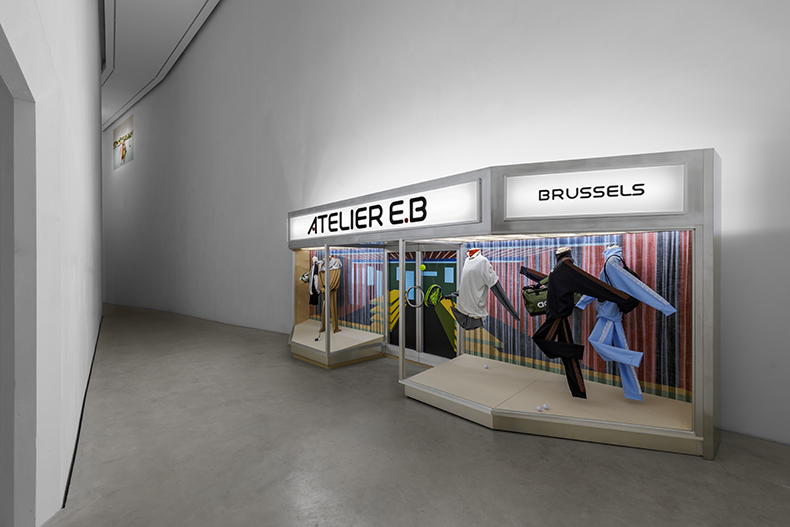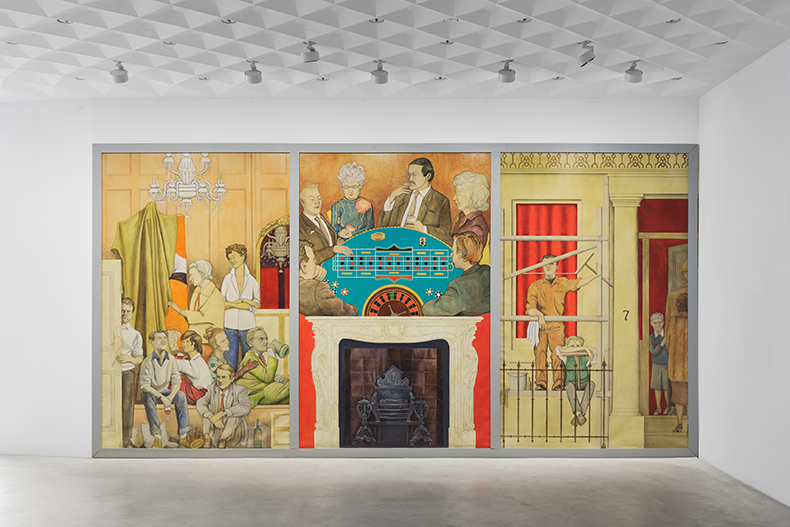To get to Hasselt from London, I take a Eurostar to Brussels followed by a regional train east toward Belgium’s border with the Netherlands. But that is not my last train ride of the day. At the heart of ‘Super Palace,’ Lucy McKenzie’s new show at Z33, is an interactive work called Moving Panorama (TransSiberian) (2024) – a burgundy train cabin in which visitors are invited to sit. Beyond its buttery curtains is a panoramic painting of a landscape, electronically rotating to give the illusion of movement.
McKenzie was inspired by Max Ophüls’ film Letter from an Unknown Woman (1948), in particular a scene where two lovers go on a fairground ride where you can pick the country (or backdrop) you’d like to travel through. ‘I thought “What is this?”’ says McKenzie, on her walkaround tour of the show. ‘It’s painting and sculpture. It’s immersive, it’s durational, it’s design, it’s technology, it’s entertainment. But most importantly, in an oppressive 19th-century culture, it was a moment of privacy. I liked the idea that it was made so that two girls could draw the curtain and finger each other.’
‘Super Palace’ is conceived of as a microcosm of a city: to enter it is to go on a journey, one that collapses boundaries between public and private, exterior and interior space, while also voyaging through McKenzie’s exhilarating, wide-ranging oeuvre. Her work zigzags between painting, sculpture, installation, fashion, interior design and film, drawing references from Eastern Europe and Belgium as well as her Scottish roots – she was born in Glasgow in 1977, and has lived in Brussels since 2007. Yet by reinterpreting popular forms – doll houses, trains, shop windows – McKenzie’s work is grounded in a comforting familiarity. For ‘Super Palace’, the space itself has been an inspiration: Francesca Torzo’s 2019 extension to Z33 rejects the regularity of the white cube in favour of a more irregular, urban architectural grammar.
Installation view of Sports Shop (2024) by Lucy McKenzie & Beca Lipscombe in ‘Super Palace’ at Z33, Hasselt. Photo: Mark Blower; courtesy the artist and Galerie Buchholz, Berlin/Cologne/New York; © the artist

As we enter up a narrow, sloping passage, we become flâneurs. At the top is Sports Shop (2024), a store front by Atelier E.B, a fashion brand McKenzie has run with fashion designer Beca Lipscombe since 2007. Round the corner, the balustraded double staircase reminded McKenzie of a train station, and she completes the effect with large advertisements for cognac and lipstick. Two plastic store mannequins (Faux Verdigris Statue (Zoya) I & II, 2024) greet us in the nude. They have been given a fake metal finish with sprayed-on Pledge, and their heads replaced with that of a Soviet war heroine. Capitalism meets communism, the sculpture throwing into stark relief how the former presents women’s bodies.
Next door, Monumental Street Lamp / 1938 Duchamp Mannequin Sketches (2017–24) takes the idea of objectification further. McKenzie sketched Lipscombe mimicking a Duchamp work in which he dressed a mannequin in his own suit, placing a phallus-shaped red light in her breast pocket. Pasting these drawings on to her own art deco marble-effect monument, her subject is ‘a lamp on a lamp’ says McKenzie, doubling down as a deconstructed streetwalker.
The showstopper here is Decap Dance Organ for Villa Ooievaar (2024), a floor-to-ceiling replica of a ‘dance organ’ created in Antwerp in the 1900s. At intervals of 20 minutes, the machine bursts into life, playing ABBA’s ‘Waterloo’ at full throttle. (McKenzie is a fan of ABBA Voyage, currently playing in London). McKenzie is interested in ‘the reality of the back’ as much as ‘the perfection of the front’, and displays the mechanism through which the music cards are fed behind the organ. Similarly, visitors are invited to view the rotating machine that provides the scenery for Moving Panorama, the mechanics of production providing a new sculptural dimension.
Monumental Street Lamp / 1938 Duchamp Mannequin Sketches (2017–24), Lucy McKenzie. Photo: Useful Art Services; courtesy the artist, Galerie Buchholz, Berlin/Cologne/New York and Cabinet, London; © the artist

McKenzie also plays with scale. The monstrous decap machine is mirrored on the wall opposite by its own miniature, with rooms behind that display literature about a model railway station from the 1935 Brussels World’s Fair, alongside her own studies for public art commissions – small documents with great creative potential. Moving Panorama sits beside a seated installation (Miniature Moving Panorama (Hudson Valley), 2024) where one can watch the same view like a peep show: at a smaller scale, the same journey goes much faster. Upstairs, a detail from Miniature Moving Panorama of a couple (a Soviet sniper and an English soldier) trying to flag down the train, is blown up in full, panicked detail.
The upstairs of the show is concerned with private, interior matters. Metal (Alan Potter) & Quodlibet LXX (2021/2022) is a diptych, the top part a painting of a wall sculpture displayed in McKenzie’s childhood living room. On the bottom part McKenzie has painted photographs of the artwork in 1980s situ. Public artwork meets private, painful nostalgia, with the lugubrious photographs showing the painting in front of ordinary domestic scenes. McKenzie’s mother worked for a charity dealing with domestic abuse, and the artist views the home as a site of violence as well as emancipation. Beyond the board a trio of mannequins lounge around. Dressed in delicate couture McKenzie made during lockdown, they wear plimsolls from Czechoslovakia, a country she associated with her liberated early travels of the 1990s.
This reverie is juxtaposed with the darker desires of Loos’ dream, a video work in which McKenzie creates a fake Czech television show from 1992. Shot in Villa Müller, designed by Adolf Loos, her script imagines the architect losing his mind among a trio of women. ‘We would have really fancied each other,’ McKenzie says. ‘I would have been into what a piece of shit he is. He would have loved what a doll girl I was. He was into teenagers. Loos is a strange depository for a lot of strange, conflicted feelings.’
Mural for Cromwell Place (Francis Bacon’s Studio) (2024), Lucy McKenzie. Photo: Useful Art Services; courtesy the artist, Galerie Buchholz, Berlin/Cologne/New York and Cabinet, London; © the artist

On either side of a selection of four classical busts (three of them Donatello’s John the Baptist) used for make-up practice are two murals. Mural for Cromwell Place (Francis Bacon’s Studio) (2024) depicts the illegal gambling den Bacon ran with his nanny at home in Mayfair. With a fireplace at the centre, the house is a shop front for both commercial goals and pleasure. The brilliantly titled Mural Proposal for Jeffrey Epstein’s New York Townhouse (Filming of American Psycho) (2024) depicts an anecdote told by American Psycho director Mary Harron: the female crew all stopped and stared when a chiselled Christian Bale derobed for the shooting of the notorious shower scene. The stacked line of women’s gazes turns the patriarchy – Bale’s Patrick Bateman has become a figurehead for incel culture – on its head. Yet despite their architectural quality and flat perspective, McKenzie’s murals are not really murals, but painted on canvas, and so are endlessly transportable. It is exciting to imagine where they might go next.
‘Lucy McKenzie: Super Palace’ is at Z33, Hasselt, until 23 February 2025.



